To address the issue of an American Standard Air Conditioner not blowing cold air, check the thermostat settings, replace or clean the air filter, inspect the condenser coils for debris, and ensure proper refrigerant levels. If problems persist, consult a professional HVAC technician.
Experiencing a sudden lapse in cooling efficiency with your American Standard Air Conditioner can be frustrating, especially during scorching weather. If you find your American Standard Air Conditioner not blowing cold air as it should, don’t panic. In this beginner-friendly guide, we’ll explore common reasons behind this issue and provide straightforward solutions to help you restore the refreshing breeze your home deserves. Discover troubleshooting tips and gain insights into ensuring your American Standard AC operates at its peak performance. Keep reading to reclaim the cool comfort you desire.
Possible Causes for AC Not Turning On
If your American Standard AC is not turning on, it can be a frustrating experience. There are several potential causes for this issue that you can investigate and resolve on your own. By addressing these possible problems, you may be able to get your AC up and running again without the need for professional assistance.
Thermostat Batteries
One common cause for an AC not turning on is dead batteries in the thermostat. The thermostat relies on batteries to send signals and communicate with the AC system. If the batteries are low or completely dead, the AC may not receive the necessary commands to start operating. Therefore, it is essential to check and replace the batteries in the thermostat regularly.
Clogged Air Filter
An often overlooked culprit of an AC not turning on is a clogged air filter. When the air filter becomes dirty and congested, it restricts the airflow, causing strain on the AC system. This strain can trigger a safety feature that shuts off the AC to prevent further damage. Therefore, it is crucial to regularly clean or replace the air filter to ensure optimal airflow and prevent the AC from shutting off.
Motor Failure
In some cases, the AC may not turn on due to a motor failure. The motor is responsible for powering the AC system, and if it fails to function properly, the AC will not start. Motor failure can occur due to various reasons, including wear and tear, electrical issues, or component malfunction. If you suspect a motor failure, it is advisable to contact a professional technician who can diagnose and repair the issue.
| Possible Cause | Description |
|---|---|
| Thermostat Batteries | The thermostat batteries may be dead or low, preventing the AC from receiving commands to turn on. |
| Clogged Air Filter | A clogged air filter restricts airflow, causing strain on the AC system and triggering a safety feature that shuts off the AC. |
| Motor Failure | A motor failure can prevent the AC from turning on. It may occur due to wear and tear, electrical issues, or component malfunction. |
If your American Standard AC is not turning on, it is worth checking the thermostat batteries, inspecting the air filter, and considering the possibility of a motor failure. By addressing these potential causes and resolving any issues, you may be able to restore the functionality of your AC system.
Possible Causes for AC Not Blowing Cold Air
When an American Standard AC is not blowing cold air, it can be quite frustrating and uncomfortable. There are several possible causes for this issue, and we will explore each of them in detail to help you identify and resolve the problem effectively.
Incorrect Thermostat Settings
One of the common reasons for an AC not blowing cold air is incorrect thermostat settings. If your thermostat is set to the wrong temperature or operating mode, it can prevent the AC from cooling properly. Make sure to check your thermostat settings and adjust them accordingly to the desired cooling temperature and mode.
Broken AC Compressor
The AC compressor plays a crucial role in the cooling process. If it is broken or malfunctioning, it can result in the AC not blowing cold air. You may hear unusual noises coming from the outdoor unit or notice reduced airflow. In such cases, it is best to contact a professional HVAC technician who can diagnose and repair the broken AC compressor.
Leaking Refrigerant
Another possible cause for an AC not blowing cold air is a refrigerant leak. Refrigerant is responsible for cooling the air within the AC system, and a leak can disrupt the cooling process. If you suspect a refrigerant leak, it is important to have it addressed promptly by a trained professional. They will be able to detect the leak, repair it, and recharge the refrigerant to ensure proper cooling functionality.
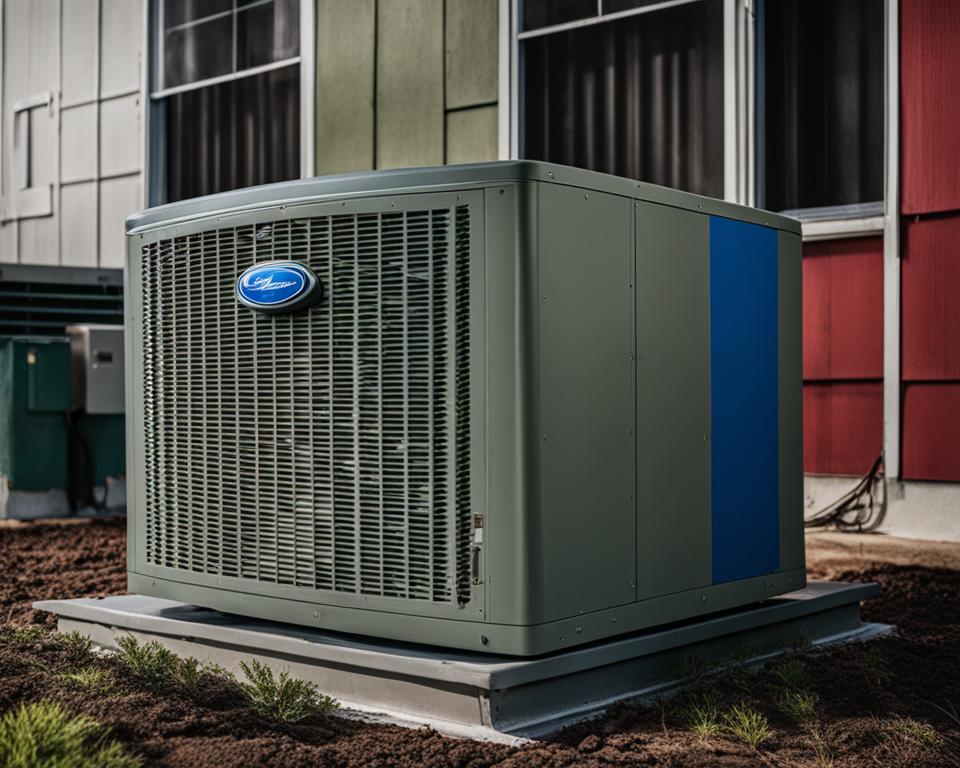
Possible Causes for AC Not Blowing Cold Air
If you find your American Standard air conditioner not blowing cold air, it can be a frustrating situation, especially during hot weather. Several factors may contribute to this issue, requiring careful inspection to identify and address the underlying causes. Understanding potential reasons for a malfunctioning American Standard AC system can help you troubleshoot and resolve the problem efficiently.
- Refrigerant Issues: One common reason for an American Standard AC not cooling properly is a refrigerant-related problem. Low refrigerant levels may result from leaks or improper charging, hindering the system’s ability to absorb and release heat effectively. A professional technician can assess and address any refrigerant issues.
- Dirty or Blocked Filters: Clogged or dirty air filters can impede the airflow, reducing the system’s efficiency. Regularly changing or cleaning the filters is crucial for maintaining optimal performance. Neglecting this routine maintenance task can lead to poor cooling and increased energy consumption.
- Thermostat Problems: Incorrect thermostat settings or a malfunctioning thermostat can result in inadequate cooling. Ensure that the thermostat is set to the desired temperature and consider recalibrating or replacing it if necessary. A faulty thermostat may inaccurately control the cooling cycle.
- Faulty Capacitor: The capacitor is responsible for providing the necessary jolt to start the compressor and fan motors. If the capacitor malfunctions, the system may struggle to initiate the cooling process. An inspection by a qualified technician can determine if the capacitor needs replacement.
- Compressor Issues: The compressor plays a vital role in the refrigeration cycle, and any malfunction can lead to reduced cooling capacity. Compressor problems may include electrical issues, mechanical failures, or excessive wear and tear. Professional diagnosis and repair are essential for resolving compressor-related issues.
- Evaporator and Condenser Coil Problems: Over time, the evaporator and condenser coils can accumulate dirt and debris, hindering heat exchange. Regular cleaning is crucial to maintain optimal performance. If the coils are severely damaged or corroded, professional cleaning or replacement may be necessary.
- Air Duct Leaks: Leaky air ducts can result in cooled air escaping before reaching the designated spaces. This inefficiency can lead to decreased cooling performance. Sealing and insulating ducts can help improve overall system efficiency and cooling effectiveness.
- Electrical Issues: Faulty wiring, tripped breakers, or other electrical issues can disrupt the proper functioning of the American Standard AC system. Professional electricians or HVAC technicians can identify and rectify electrical problems to ensure reliable performance.
Possible Causes for AC Continuously Running
If your American Standard AC is continuously running and won’t turn off, it can be a cause for concern. Several factors can contribute to this issue, including a faulty thermostat, an incorrectly sized system, and external factors. Here, we will discuss each of these potential causes and provide steps to troubleshoot and resolve the problem.
Faulty Thermostat
A faulty thermostat is a common culprit behind an AC that continues to run. If your thermostat is not functioning properly, it may not be able to accurately sense the temperature and signal the AC to turn off when the desired temperature is reached. To troubleshoot a faulty thermostat:
- Check the thermostat setting to ensure it is set to the desired temperature.
- Inspect the thermostat for any visible damage or loose wires.
- Reset the thermostat by turning it off and removing the batteries (if applicable) for a few minutes before reinstalling them and turning it back on.
- If the issue persists, consider replacing the thermostat or contacting a professional for assistance.
Incorrectly Sized System
Another reason for an AC that runs continuously is an incorrectly sized system. If your AC unit is too small for the space it is supposed to cool, it may struggle to reach the desired temperature, causing it to run constantly. On the other hand, if the system is oversized, it may cool the space quickly but turn off and on frequently. To address an incorrectly sized system:
- Consult a professional HVAC technician to assess the size requirements for your space.
- If the system is undersized, consider upgrading to a larger unit that can effectively cool your home.
- If the system is oversized, explore options to optimize its performance or consider downsizing to a more suitable unit.
External Factors
External factors, such as unusually high temperatures or excessive heat load, can also cause an AC to run continuously. In hot climates or during heatwaves, the AC may struggle to keep up with the demand for cooling. To mitigate the impact of external factors:
Ensure proper insulation in your home to reduce heat transfer and keep your space cooler.
In areas with high outdoor temperatures, consider using shades, curtains, or blinds to block direct sunlight and reduce the heat entering your home. Proper ventilation and airflow management can also help alleviate the strain on your AC system.
Summary
In summary, if your American Standard AC is continuously running, the potential causes include a faulty thermostat, an incorrectly sized system, and external factors such as high temperatures. By troubleshooting these issues and taking appropriate steps, you can address the problem and restore the optimal functioning of your AC system.
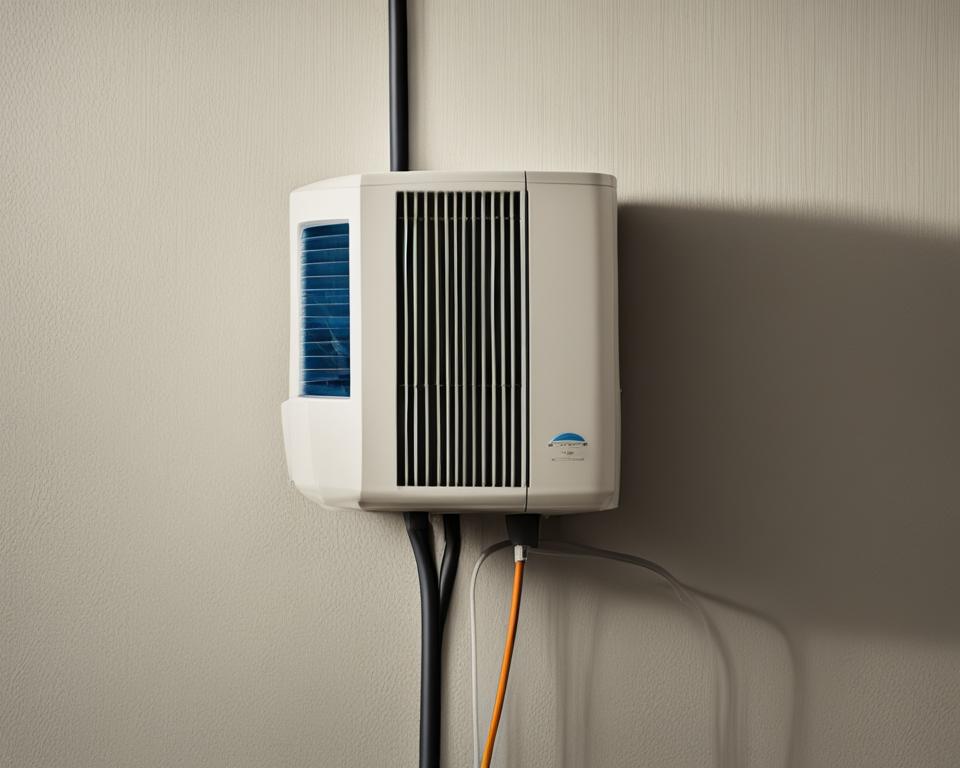
Signs it’s Time for AC Replacement
In some cases, repairing an old air conditioner may not be the best solution. There are several signs that indicate it’s time to consider AC replacement. By recognizing these signs early on, you can save yourself from frequent repairs, strange noises, and high energy bills.
- Age of the Air Conditioner: If your air conditioner is over 20 years old, it may be approaching the end of its lifespan. Older AC units are less energy-efficient and more prone to breakdowns. Consider replacing your old air conditioner with a newer model that offers improved performance and energy savings.
- Frequent Need for Repairs: If you find yourself frequently calling for repairs or experiencing recurring issues with your AC, it may be more cost-effective to replace the unit. Continuously investing in repairs can add up quickly, and a new air conditioner would provide reliable cooling without the hassle of frequent breakdowns.
- Strange Noises and Smells: Unusual sounds and odors coming from your air conditioner can indicate underlying problems. Strange noises or smells may be a sign of worn-out components or even mold growth. If these issues persist despite repairs, it’s a good indication that your AC needs to be replaced.
- High Energy Bills: If you notice a significant increase in your energy bills despite normal usage, it could be a sign that your air conditioner is no longer operating efficiently. Old AC units tend to consume more energy to cool your home, resulting in higher utility costs. Upgrading to a newer, energy-efficient model can help you save money in the long run.
Considering these signs, it’s important to assess the overall condition and performance of your air conditioner. If you’re unsure about whether to repair or replace, consult with a professional HVAC technician who can provide expert advice based on your specific situation.
| Signs it’s Time for AC Replacement | Benefits of AC Replacement |
|---|---|
| Old air conditioner (over 20 years old) | Improved energy efficiency |
| Frequent repairs | Reliable cooling performance |
| Strange noises and smells | Reduced risk of breakdowns |
| High energy bills | Cost savings on utility bills |
Preventing AC Issues
Regular maintenance is crucial for preventing AC issues and ensuring optimal performance. By following a few simple steps, you can keep your American Standard air conditioner running smoothly and avoid costly repairs.
Changing Air Filters
One of the most important maintenance tasks is regularly changing the air filters. Over time, dust, dirt, and debris can clog the filters, restricting airflow and reducing efficiency. We recommend changing the air filters every 1 to 3 months, depending on usage and air quality. Clean filters will not only improve cooling performance but also help maintain healthier indoor air quality.
Keeping the Area Clean
It’s essential to keep the area around the AC system clean and free of debris. Debris, such as leaves, grass clippings, and branches, can accumulate and block airflow, leading to reduced cooling efficiency. Regularly inspect the outdoor unit and remove any debris to ensure proper airflow and prevent potential damage to the system.
Scheduling Professional Maintenance
While simple maintenance tasks can be done by homeowners, scheduling professional maintenance at least twice a year is highly recommended. HVAC professionals have the expertise to diagnose and address any potential issues before they escalate into major problems. During a professional maintenance visit, technicians will inspect, clean, and tune up your air conditioner, ensuring optimal performance and efficiency.
“Regular maintenance is key to preventing AC issues.”
By preventing AC issues through regular maintenance, you can enjoy a cool and comfortable home throughout the year. Remember, taking proactive measures can help extend the lifespan of your American Standard air conditioner and save you money in the long run.
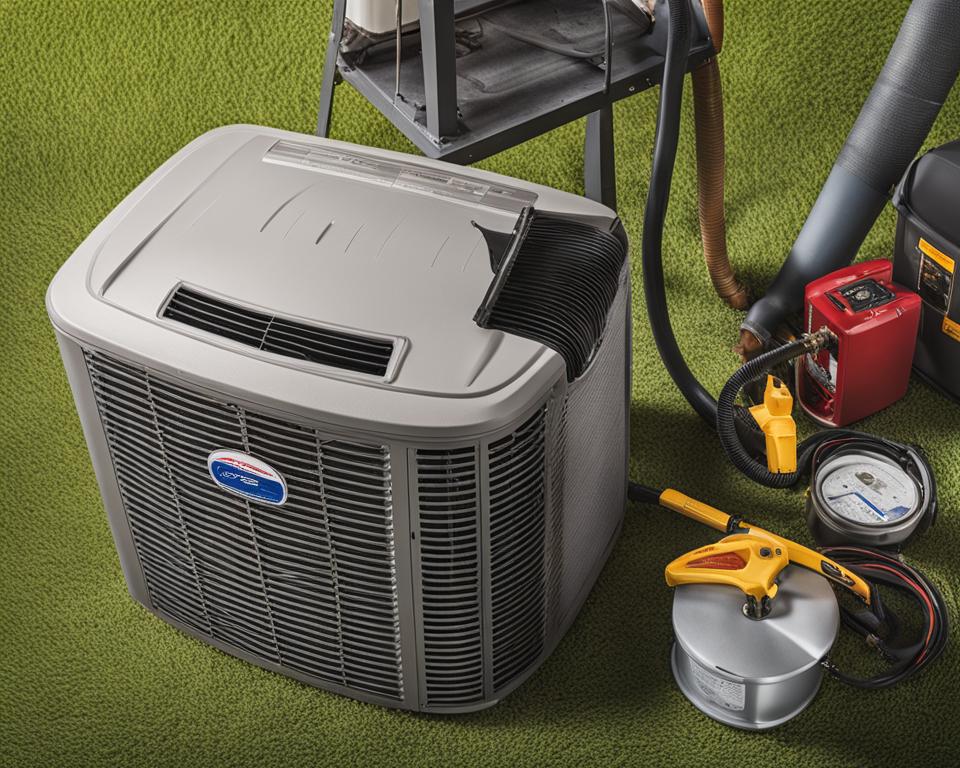
| Maintenance Tasks | Frequency |
|---|---|
| Change air filters | Every 1 to 3 months |
| Inspect outdoor unit and clean | Regularly |
| Schedule professional maintenance | Twice a year |
Troubleshooting Tips for AC Not Turning On
When your American Standard AC is not turning on, it can be frustrating and worrisome. However, there are several troubleshooting steps you can take to identify and resolve the issue. Follow these tips to get your AC up and running again:
- Check the Thermostat: Ensure that the thermostat is set to the correct temperature and cooling mode. Sometimes, a simple adjustment can solve the problem.
- Change the Batteries: If your thermostat uses batteries, check if they are low or dead. Replace them with fresh batteries and see if that restores power to your AC.
- Inspect the Air Filter: A clogged or dirty air filter can prevent your AC from turning on. Locate the air filter and check if it needs cleaning or replacement. A clean filter promotes better airflow and improves overall system performance.
If these troubleshooting tips do not resolve the issue, it might be time to call a professional HVAC technician. They have the expertise to diagnose and fix more complex problems with your AC system.
Remember, regular maintenance is crucial for the optimal functioning of your American Standard AC. It is advisable to schedule professional maintenance at least once a year to prevent issues and ensure the longevity of your cooling system.
Quote:
“Proper care and maintenance can prevent many common AC problems. By checking the thermostat, changing batteries, and inspecting the air filter, you can troubleshoot and resolve AC not turning on issues.” – HVAC Experts
Now that we have discussed troubleshooting tips for AC not turning on, let’s move on to the next section where we will provide guidance on troubleshooting AC not blowing cold air.
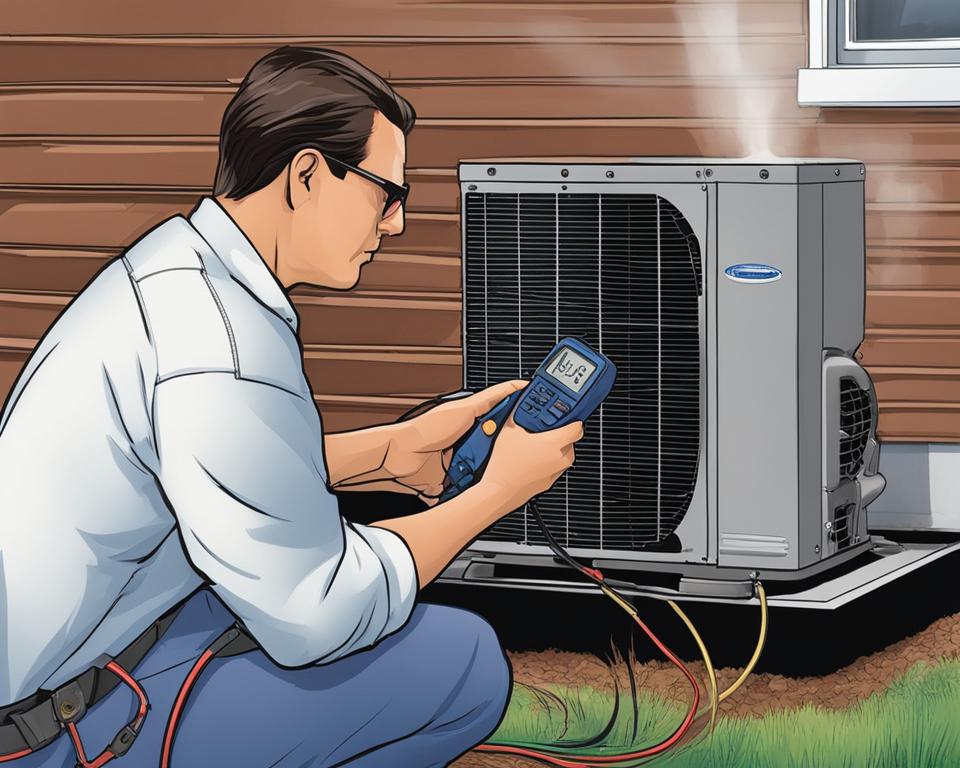
Stay tuned for the upcoming section, where we will discuss troubleshooting tips for when your AC is continuously running and won’t turn off.
Troubleshooting Tips for AC Continuously Running
Is your American Standard AC running continuously and not turning off? Don’t worry, we’re here to help you troubleshoot and resolve this issue. Follow these expert tips to get your AC system back to normal:
1. Check Thermostat Settings
Start by verifying your thermostat settings. Make sure the thermostat is set to the desired temperature and the fan is set to “Auto.” If the thermostat is set to “On” instead of “Auto,” the AC fan will continue to run even when the cooling cycle is complete.
2. Assess HVAC System Size
It’s essential to ensure that your AC system is properly sized for your home. An oversized AC unit may cause the system to run longer than necessary, resulting in continuous operation. If you suspect that your system is oversized, it’s recommended to consult with an HVAC professional to assess and adjust the system size accordingly.
3. Consider External Factors
External factors, such as high temperatures, can cause your AC to run continuously. If you’re experiencing exceptionally hot weather, your AC may need to work harder to maintain the desired temperature, leading to continuous operation. While you can’t control the weather, you can take steps to keep your home cool and reduce the workload on your AC, such as using shades, curtains, or blinds to block direct sunlight and keeping doors and windows closed during the hottest parts of the day.
| External Factors | Solutions |
|---|---|
| High outdoor temperatures | Use shading devices, close doors and windows |
| Heat-generating appliances | Minimize use during hot periods |
| Poor insulation or air leaks | Seal air leaks and improve insulation |
| Excessive humidity | Use a dehumidifier |
By considering these external factors and implementing appropriate measures, you can help your AC system operate more efficiently and prevent it from running continuously.
Remember, if you’ve followed these troubleshooting tips and your American Standard AC still won’t turn off, it may be time to seek professional help. An HVAC technician can diagnose and address any underlying issues that may be causing the continuous operation of your AC system.
Continue reading to learn when it might be time to consider AC replacement and other proactive measures to prevent future AC issues.
Conclusion
In conclusion, troubleshooting your American Standard air conditioner not blowing cold air can be a frustrating experience, but by following the steps outlined in this guide, you can identify and address the issue effectively. Regular maintenance, such as cleaning or replacing air filters and checking for refrigerant leaks, is crucial to ensure optimal performance. If problems persist, it’s advisable to consult with a professional technician familiar with American Standard AC systems. By staying proactive and addressing issues promptly, you’ll not only restore your cooling comfort but also extend the lifespan of your American Standard AC unit.

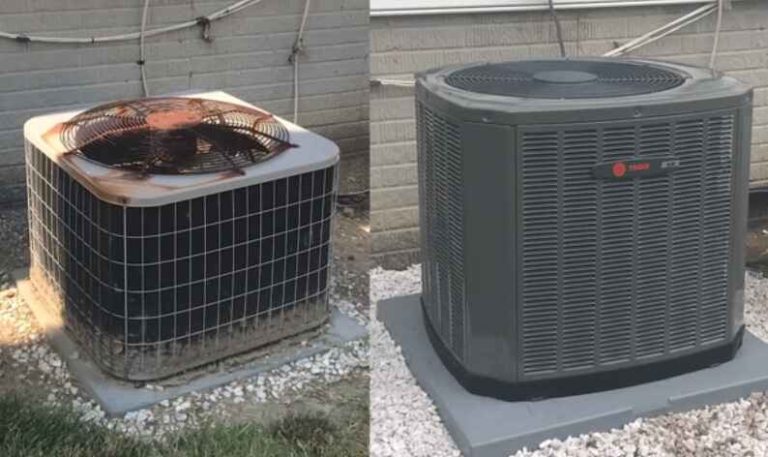
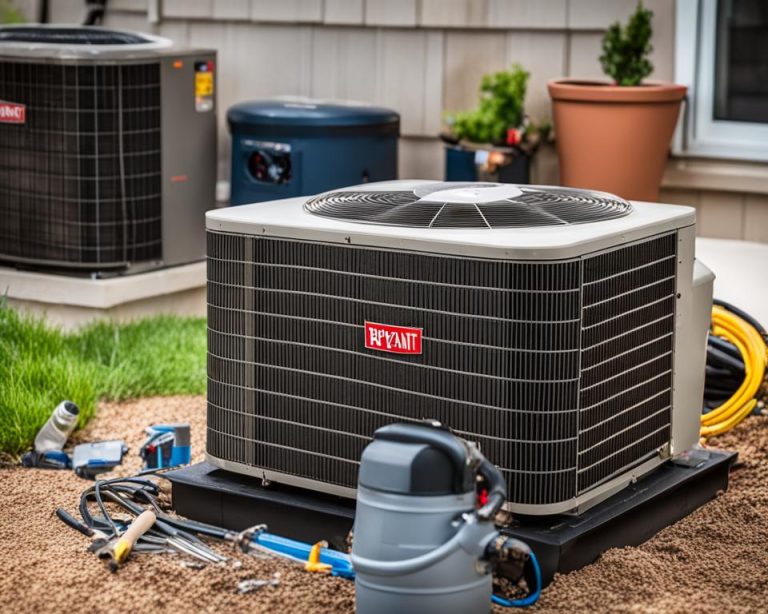
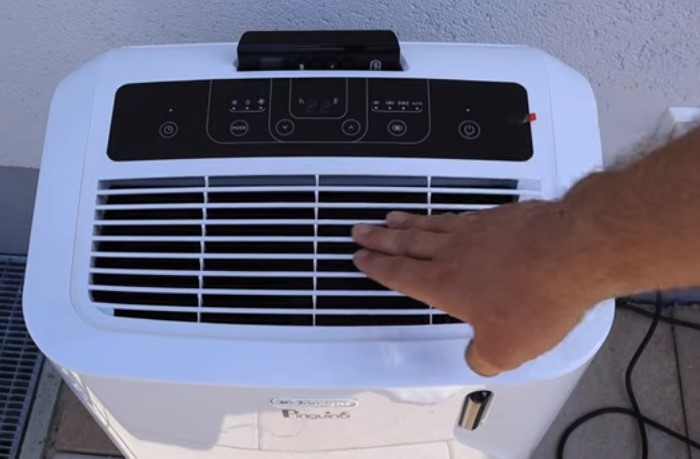

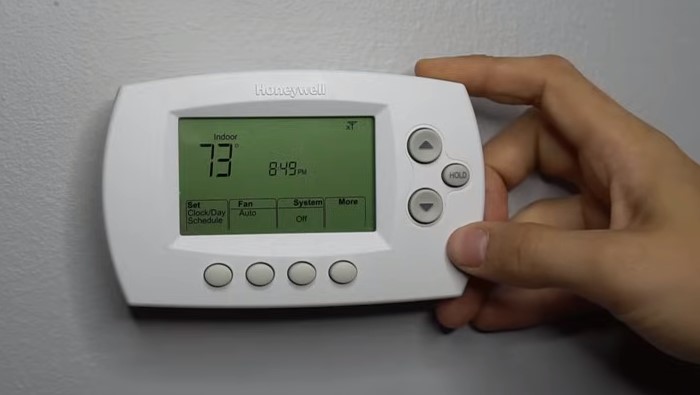
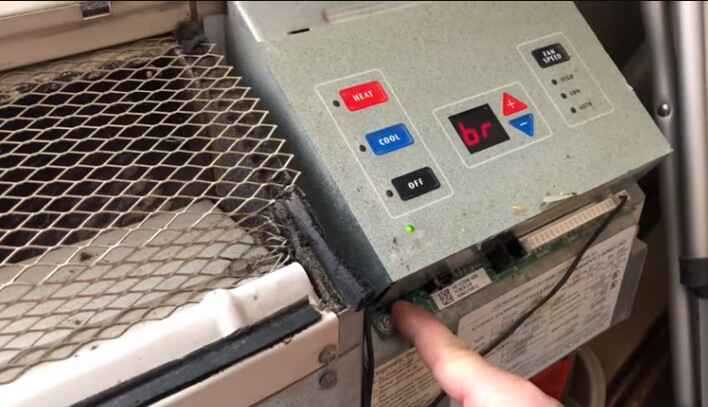
4 Comments